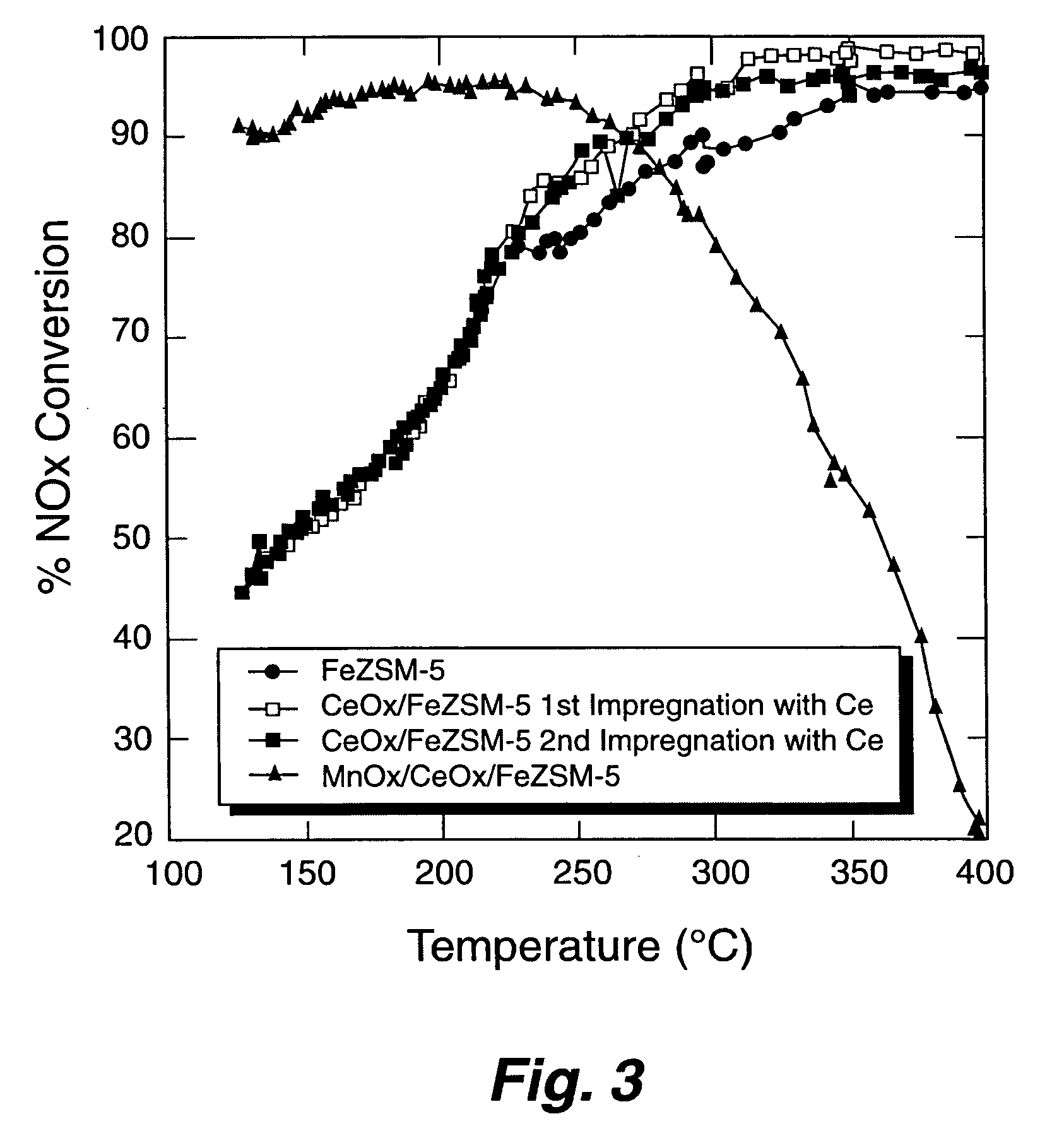Catalyst and method for reduction of nitrogen oxides
a nitrogen oxide and catalyst technology, applied in the field of nitrogen oxide abatement, can solve the problems of no simple, economical method or catalyst for inducing the decomposition of gases, no simple catalyst or catalyst has been described for inducing the decomposition, and no simple catalyst or catalyst is described for reducing gases /sub>. economic feasibility, and achieve the effect of reducing nitrogen oxides
- Summary
- Abstract
- Description
- Claims
- Application Information
AI Technical Summary
Benefits of technology
Problems solved by technology
Method used
Image
Examples
example 1
Preparation of Fe ZSM-5 Supported on Cordierite Monolith.
[0055] Cylinders of cordierite monolith (10 mm in diameter×12 mm long; 400 cells per inch2) were coated with H-ZSM-5 (ZEOLYST INTERNATIONAL) zeolite by dipping the monolith into an aqueous slurry of the zeolite powder followed by drying at 110 degrees Celsius. Several cycles of coating followed by drying were necessary to achieve a zeolite coating of around 20 to 24 percent by weight. The coated monolith was then calcined at a temperature of about 500 degrees Celsius. Iron was exchanged into the pores of the zeolites by the well-known method of gas-phase exchange using FeCl3 as the volatile iron component. A piece of ZSM-5 coated cordierite monolith was placed into a boat downstream from a boat of anhydrous FeCl3. The boats were contained within a quartz apparatus that was purged with dry nitrogen gas. The quartz apparatus was heated to a temperature of from between 300 degrees Celsius and 325 degrees Celsius to initiate the ...
example 2
Testing of Fe ZSM-5 Monolith Catalyst
[0056] The Fe-ZSM-5 / monolith prepared according to EXAMPLE 1 was tested for NOx conversion activity and for NO oxidation activity. To measure the activity for NOx conversion, the Fe-ZSM-5 / monolith was placed into a 10 mm diameter quartz reactor tube. Reaction gases (NO, NO2, NH3, and O2 in He) were blended using mass flow controllers to produce a gas mixture having 350 parts per million (ppm) total NOx, 350 ppm NH3, and 12 percent O2; 5 percent steam was added using a syringe pump and an evaporator. The NO:NO2 ratio was either 1:1 or 4:1. The space velocity was either 30,000 h−1 or 60,000 h−1. Products and reactants (NO, NO2, N2O, NH3) were analyzed using a Fourier Transform Infrared (FT-IR) spectrometer with a heated cell having a 2 meter, or 10 meter, path length. Nitrogen was measured using a gas chromatograph. Operation of the reactor was automated. Catalytic performance data was obtained over the temperature range of 500 degrees Celsius to ...
example 3
Preparation of MnOx / Y Catalyst
[0058] MnOx supported on zeolite Y catalyst comparable to a catalyst reported by Yang et al. (“A Superior Catalyst for Low-Temperature NO Reduction With NH3,” Chem. Commun. (2003), pp. 848-849) was prepared by incipient wetness impregnation. A six gram sample of zeolite Y (ZEOLYST®) was impregnated with approximately 3 cubic centimeters (cc) of 5 molar manganous nitrate solution to achieve a catalyst having approximately 10 to 15 percent by weight Mn. The catalyst was dried at a temperature of about 120 degrees Celsius, and then calcined at a temperature of about 500 degrees Celsius.
PUM
 Login to View More
Login to View More Abstract
Description
Claims
Application Information
 Login to View More
Login to View More - R&D
- Intellectual Property
- Life Sciences
- Materials
- Tech Scout
- Unparalleled Data Quality
- Higher Quality Content
- 60% Fewer Hallucinations
Browse by: Latest US Patents, China's latest patents, Technical Efficacy Thesaurus, Application Domain, Technology Topic, Popular Technical Reports.
© 2025 PatSnap. All rights reserved.Legal|Privacy policy|Modern Slavery Act Transparency Statement|Sitemap|About US| Contact US: help@patsnap.com



